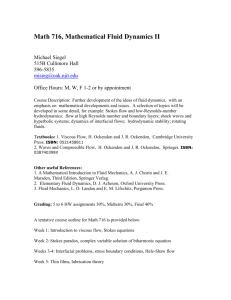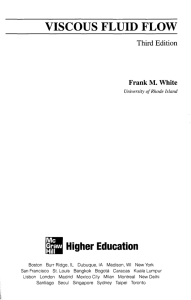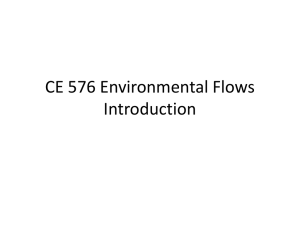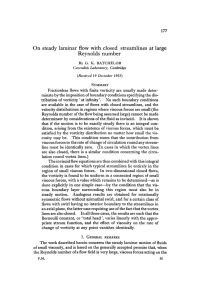Syllabus ()
advertisement
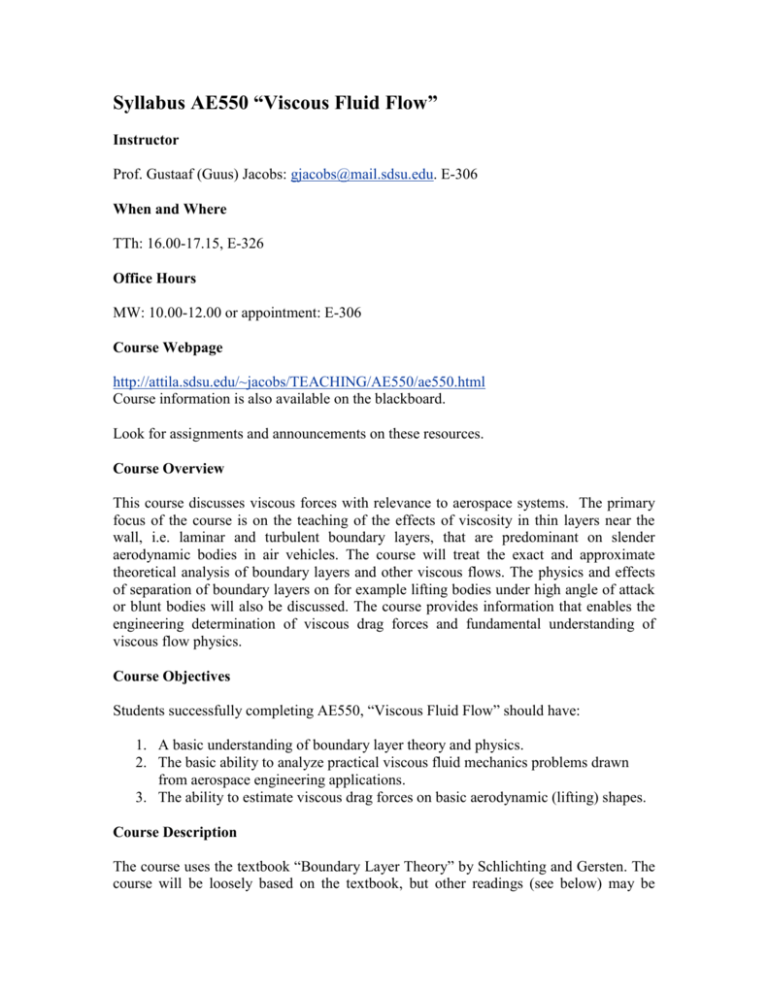
Syllabus AE550 “Viscous Fluid Flow” Instructor Prof. Gustaaf (Guus) Jacobs: gjacobs@mail.sdsu.edu. E-306 When and Where TTh: 16.00-17.15, E-326 Office Hours MW: 10.00-12.00 or appointment: E-306 Course Webpage http://attila.sdsu.edu/~jacobs/TEACHING/AE550/ae550.html Course information is also available on the blackboard. Look for assignments and announcements on these resources. Course Overview This course discusses viscous forces with relevance to aerospace systems. The primary focus of the course is on the teaching of the effects of viscosity in thin layers near the wall, i.e. laminar and turbulent boundary layers, that are predominant on slender aerodynamic bodies in air vehicles. The course will treat the exact and approximate theoretical analysis of boundary layers and other viscous flows. The physics and effects of separation of boundary layers on for example lifting bodies under high angle of attack or blunt bodies will also be discussed. The course provides information that enables the engineering determination of viscous drag forces and fundamental understanding of viscous flow physics. Course Objectives Students successfully completing AE550, “Viscous Fluid Flow” should have: 1. A basic understanding of boundary layer theory and physics. 2. The basic ability to analyze practical viscous fluid mechanics problems drawn from aerospace engineering applications. 3. The ability to estimate viscous drag forces on basic aerodynamic (lifting) shapes. Course Description The course uses the textbook “Boundary Layer Theory” by Schlichting and Gersten. The course will be loosely based on the textbook, but other readings (see below) may be involved. We will first discuss some physics aspects of viscous flows. We then discuss the governing viscous flow models and some analytical solutions thereof. Prandtl’s laminar boundary layer equations are then derived, followed by the analysis of the boundary layer over a flat plate. Approximate “integral” and numerical solutions of the boundary layer equations are discussed. We will then estimate the laminar flow separation location. After a brief discussion on the transition of the boundary layer from laminar to turbulent, we derive the turbulent boundary equations, and discuss turbulence modeling in boundary layers. Textbook Schlichting, H. and Gersten, K., “Boundary Layer Theory”, 8th Revised and Enlarged Edition, Springer-Verlag, 2000. Supplementary Textbooks Viscous Flows: White, F.M., “Viscous Fluid Flow”, McGrawHill, 1991. . Fluid Mechanics: Anderson, J.D. Jr.., “Fundamentals of Aerodynamics”, 4th Edition, Mcaw-Hill, 2007. Anderson, J.D., “Modern Compressible Flow: With Historical Perspective”, McGrawHill, 2002. Katz, J. and A. Plotkin. Low-Speed Aerodynamics: From Wing Theory to Panel Methods. New York, NY: McGraw-Hill, Inc., 1991. Turbulent Flows: Pope, S., “Turbulent Flows”, Camebridge University Press, 2000. Computational Fluid Dynamics: Anderson, J.D., “Computational Fluid Dynamics: The Basics with Applications”, McGrawHill, 1995. Wilcox, D.C., “Turbulence Modeling for CFD”, DCW Industries, Third Edition, 2006. Prerequisites Students are expected to have a good understanding of basic fluid mechanics (EM340) and aerodynamics (AE301, AE302). Basic programming skills will be needed. Homework Problems A total of approximately six to nine problem sets and computer assignments will be given on Thursdays and on a weekly or bi-weekly basis. The due date for submission of assignments is at the beginning of class one or two (depending on the size of the homework) Thursdays after the assignment is given. Late submission of assignments is not accepted. Projects Currently, one project is planned. The project replaces the final exam, and will combine a theoretical analysis with a computational verification... Homework and Project Collaboration While discussion of the homework and projects is encouraged among students, the work submitted for grading must represent your understanding of the subject matter. Significant help from other sources should be noted. Exams There will be on mideterm in-class exams, Course Grade The grading will be based on a weighting of 30 % on the homework, 30 % on the midterm project, and 40 % on the final project. Policies Regular and punctual attendance and participation are expected. Absence from tests must be explained with medical certificates or other valid reasons beyond your control and planning. Ask anyone for help on homework, but what you submit must be your own work.

